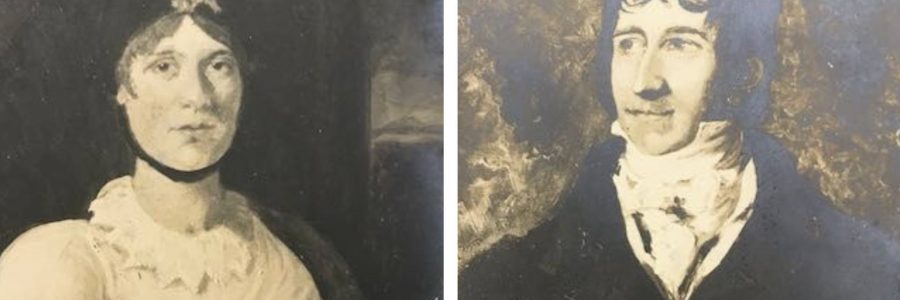
The Paget family of East Anglia
Post by Sam Evans (Assistant Archivist, Archives & Modern Manuscripts)
Last year, the University Library acquired a substantial part of the Paget family archive as a gift from Sir Adam Thomson and his extended family. I recently completed a catalogue of the collection (MS Add. 10379), as an assignment for a course in Archive Administration undertaken by distance learning at Aberystwyth University. The work, which I completed with the support of colleagues in the Archives and Modern Manuscripts Department, was challenging but fascinating. The bare bones of the family history shows the Pagets’ strong local (East Anglian) connections and also their global reach. Samuel Paget was a brewer and ship owner in Great Yarmouth and came to prominence provisioning ships during the Napoleonic wars. The family experienced a severe financial crisis in the 1820s and Samuel was forced to sell his house on the quay at Great Yarmouth and his art collection. His wife, Sarah Elizabeth, known as Betsey, was a keen artist, collector, and chronicler of events, and the habit of keeping a family history was passed on, in particular to their son Alfred.
Betsey bore seventeen children, of whom nine survived to adulthood. Two of them, George Edward Paget and James Paget, had successful careers in medicine. George Edward Paget, who became Regius Professor of Physic at Cambridge University, married Clara Fardell, an antiquarian with family links to Wales, and later a regular reader at the University Library (Jill Whitelock, ‘“Lock up your libraries”? Women readers at Cambridge University Library, 1855–1923’, Library & Information History 38 (2022): 1–22 (p. 14)).
They had ten children, three of whom died in infancy. Their daughter Maud married the German-born ornithologist Hans Gadow and lived in Great Shelford, near Cambridge. Their daughter Rose married the physicist J. J. Thomson, Cavendish Professor of Physics at the University of Cambridge. Their daughter Violet, Rose’s twin, married, as her second husband, J. H. Batty, a businessman with interests in African mines and trading. Their son George Edmund Paget (known as Edmund), became a stockbroker, and married Stella Salomons. Edmund and Stella’s son Arthur Richard Paget married Ichi Watanabe in 1911 and lived in Japan.
As I started work on box lists, it became clear that this was very much a conscious family history collection. Bundles were carefully labelled (although labels did not necessarily exactly match contents), and the labels were often full of emotion: there were frequent references to ‘dear’ so-and-so, and pleas not to throw things away. The development of the collection could be guessed at: as each elder relative died, souvenirs had been passed to the next generation, who in turn passed on their collected bundles to a new generation, who collated, added to, and documented their collections as far as they could, and increasingly gathered the scattered items into one set. There were also plenty of loose items, that did not seem to belong to any existing bundle. The result was a bit overwhelming. My initial tidy-minded impulse to reorganise by format (letters, photographs, pamphlets, notes, sketches, etc) was discarded after discussion with colleagues. One item, a Victorian writing desk used as a memory box, definitely could not be broken up, even though the rationale for some of the contents was obscure. It belonged for a time to Maud, and contained, amongst other things, mementos of two of her siblings who died as infants.
By extension, we decided, the other collections should not, in general, be broken up: the reason for things being put together might be unclear to us and might in fact be rather random, but once the context was lost, it would be hard to recover.
As a result of this, letters by George Edward Paget (just to give one example) crop up at many points in the collection. Not only did he write to most members of the family, but Maud tended to use the blank backs of his letters as labels for bundles. The latter point created a cataloguing conundrum: should the letter be catalogued as a letter or a label or should it be treated as part of the container? (I catalogued them as letters and mentioned their use as a labels in the Scope and contents notes.) We hoped the ability to cross-search the catalogue would mitigate the inconvenience of this scattering.
How to collate the bundles and single items was also a puzzle. In the end, I proposed creating subfonds associated, for the most part, with individuals or small family units. These were, where I could identify them, the collators of various bundles; the authors of the contents of bundles or single items; or the principal subject of bundles or single items. Admittedly, assigning items to subfonds was sometimes subjective. However, perfection was impossible, and it seemed that getting a catalogue published (and my assignment finished) in good time was a more important goal. I was heartened to find some support in a letter quoted in the typescript volume of family history included in the collection:
‘It is a hard duty to disturb such relics … My wish had always been that the doings, the writings, the paintings, everything which showed the very mind itself of all or any of us should be kept together in one mass. If we separate the things, we shall perhaps forget the chief characteristics of their minds … We separate and cannot take such care as if all were in one heap at home. Moving about and making other collections it is very possible some may be lost.’
Alfred Tolver Paget to George Edward Paget, 30 August 1844 (The Pagets of Great Yarmouth, 1800–1850, p. [i], MS Add.10379/3/5)
My assignment offered a bit of a diversion at this point: I had the option of describing how the catalogue was prepared using ISAD(G) principles (International Standard Archival Description (General): a traditional hierarchical model), or how it could have been prepared using ICA (International Council on Archives) Records in Context guidelines, which use networks rather than hierarchies. The Records in Context option struck me as difficult, since as far as I know Records in Context still has no practical instantiation and is not supported by archival software. It would, however, have offered interesting possibilities, since items could perhaps be given tags equivalent to ‘created by ..’, ‘collected by …’, ‘has as subject …’, ‘part of …’, allowing multiple arrangements of data at least at the catalogue level. Some of this richness could no doubt be replicated in ArchivesSearch using agent records and other tags at the item level, if time permitted (which, in the end, it did not). However, the physical material still needed to be organised hierarchically, in files, folders, and boxes, in a form that was helpful to researchers. In the end, I did not pursue Records in Context.
The Paget collection has some distinctive features. I am already familiar with the Darwin Archive at the University Library, and one thing that struck me early on was that Pagets, unlike Darwins, perhaps as a result of early training in record-keeping by Betsey, generally dated letters properly, with day, month, and year, while Darwins frequently did not. The Pagets, also, were very keen on collecting locks of hair and pressed flowers and leaves. Sometimes these are carefully labelled with name and date (for hair) or date and location (for plant material); but sometimes a leaf or flower is just tucked into a letter or pamphlet with no explanation.
To avoid having readers accidentally shower themselves with hair or plant material, these had to be removed, where possible, to card envelopes with a warning posted on the outside. Darwins, as far as we can tell, did not bother quite so much with hair, and although there is plenty of plant material in the Darwin archive, it was usually sent for scientific purposes. Many of the Pagets were gifted amateur artists. There is a sketchbook by Alfred Tolver Paget from a trip to France in 1834, when he was 16.
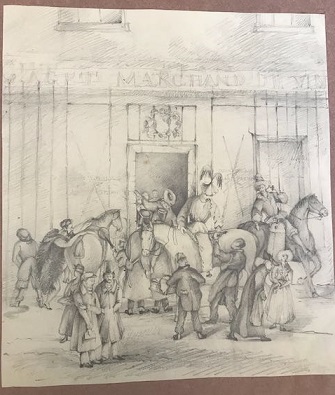
This cut-out drawing of a disconsolate Cambridge academic accompanies a description, probably by an older Alfred, of arriving in Cambridge in the evening and finding the tobacconists all closed and no friends available to share their tobacco.
The stunning portrait image below left may be a picture of Violet by Maud. Elise Paget exhibited at the Royal Academy. There is one watercolour by her in the collection (below right). It is possible that the collection of pencil drawings of buildings, mostly in London, in MS Add.10379/10/15/1 are also by Elise. The collection, prior to deposit at the University Library, was used extensively by M. Jeanne Peterson in her book Family, Love, and Work in the Lives of Victorian Gentlewomen (Bloomington and Indianapolis: Indiana University Press, 1989), and is a rich source of material on pre-Victorian and Victorian middle-class family, professional, and business life; there is also a good deal of post-Victorian material. There are many letters between members of the family: after George Edward Paget built a holiday home in Wales, Clara Paget spent the summers there with the younger children, leaving her elder daughters to run the house in Cambridge and look after their father. She sent instructions to them in regular, rather terse, letters. There are also journals and sketchbooks of foreign travels.
For more on cataloguing family papers, see Elizabeth Wells, ‘Related material: the arrangement and description of family papers’, Journal of the Society of Archivists 33 (2012): 167–84).


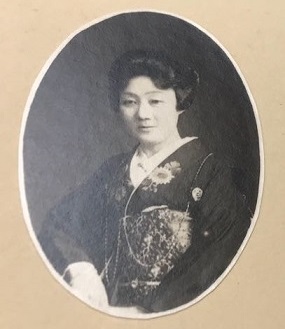

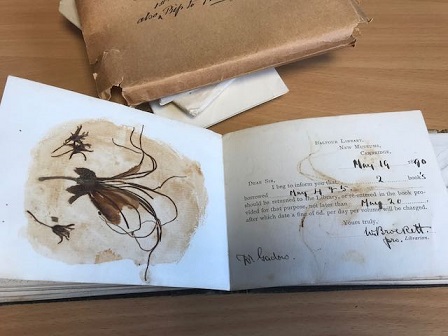
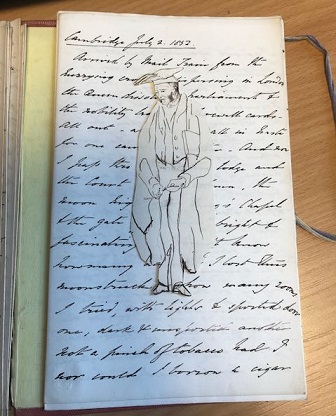

A fascinating article for one such as me — Samuel Paget was my paternal 3x great-grandfather. I understand that as Mayor of Great Yarmouth, and head of the local militia, he led the parade to welcome Nelson and the Hamiltons back to England. There is much here that I did not know of our family history, and which is probably unknown to many of my generation. A note that might be of interest is that my paternal grandparents lived for 24 years in Down House, in the village of Downe, Kent, the home of Charles Darwin.
How fascinating! Thanks for getting in touch. What a wonderful link to history your family has. (Liam Sims, Rare Books Specialist)